Creating a personalized agricultural planting calendar is key for gardeners to get great harvests. Knowing the best times to plant and the dates for different crops helps gardeners make the most of their growing season. This guide will help you understand the importance of planting dates and how to plan your planting schedule. It will also show you how to avoid crop failures and increase your yields.
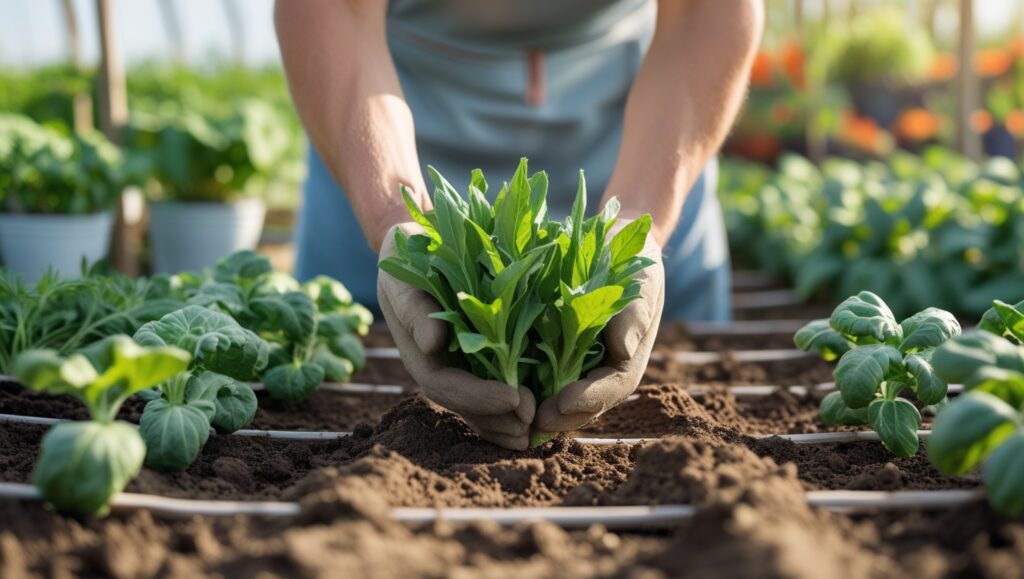
Introduction to Optimal Planting Times
Knowing your local climate and growing conditions is important for picking the right planting times. By considering cool-season and warm-season crops, you can plan your planting calendar well. For example, plant cool-season crops from September to February and warm-season crops from March to August. This way, you can make sure your crops get the best care at the right time.
Table of Contents
Understanding Crop Planting Dates and Their Importance
Timing is key when planting crops. A planting season guide helps gardeners find the best time to plant crops. It considers climate, soil temperature, and moisture levels. Following a planting schedule boosts crop yields and lowers failure risks.
Cool-season veggies like broccoli and kale do well in early spring or late summer. The soil is cool and moist then. Warm-season crops, such as tomatoes and peppers, thrive in late spring or early summer. The soil is warm enough by then.
It’s not just about the guide. Gardeners must also think about soil temperature and moisture. By planning carefully, gardeners can enjoy a successful harvest.
Key Factors That Influence Planting Times
Creating a successful planting timeline requires careful consideration of several key factors. These factors are crucial for finding the best seasonal planting dates for different crops. Climate, soil temperature, and moisture levels are among the most important.
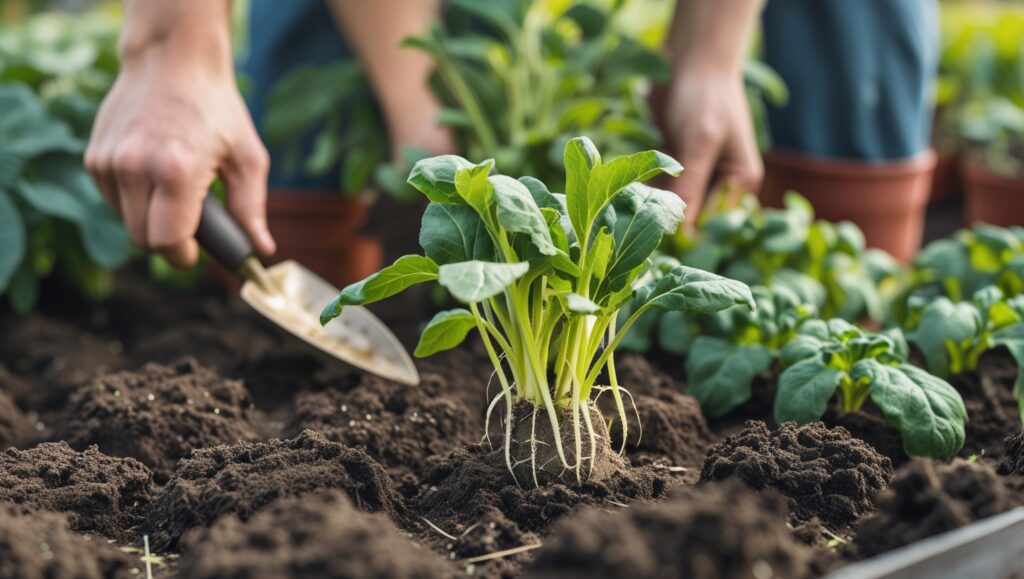
Agricultural experts stress the need to consider these factors when planning a planting timeline. For example, corn needs to absorb about 30% of its weight in water before it starts to grow. The soil should be around 50° F for planting corn. Soybean seeds are most vulnerable to cold in the first 24 hours after planting.
By considering these factors, gardeners can create a planting timeline that suits their local conditions. This helps them make informed decisions about when to plant. It ensures the best results for their crops. Key considerations include:
- Soil temperature and moisture levels
- Climate and weather patterns
- Crop specific requirements, such as days-to-maturity
- Regional seasonal planting dates and frost dates

By planning carefully and considering these factors, gardeners can increase their chances of a successful harvest. Whether planting corn, soybeans, or other crops, understanding these key factors is vital for the best results.
| Crop | Optimal Soil Temperature | Moisture Requirements |
|---|---|---|
| Corn | 50° F | 30% of kernel weight |
| Soybeans | 40° F | 20% of seed weight |
Regional Climate Zones and Their Effect on Planting
Knowing about regional climate zones is key for a good crop planting calendar and agricultural planting calendar. The United States has different climate zones, each with its own traits and challenges. Gardeners need to think about these when planning their planting schedule for the best growth and yield.
The USDA Hardiness Zones help figure out the best planting times for crops. These zones are based on the coldest temperature of the year. They tell gardeners which plants will do well in their area. By looking at local frost dates, growing seasons, and microclimate conditions, gardeners can make a crop planting calendar that fits their needs.
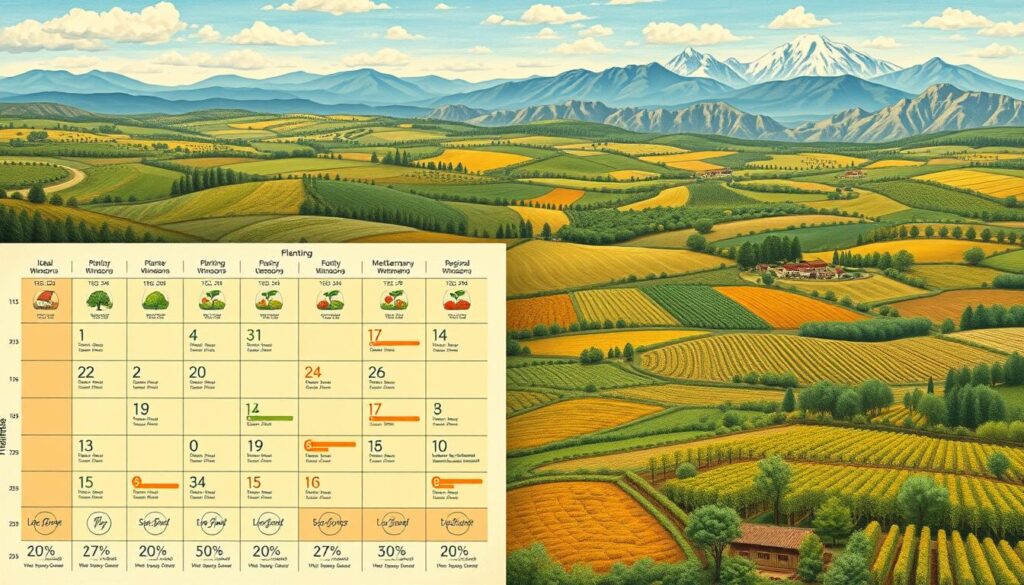
Some important things to think about when making a crop planting calendar include:
- USDA Hardiness Zones
- Local frost dates
- Growing seasons
- Microclimate conditions
By considering these, gardeners can create a agricultural planting calendar that maximizes their growing season. This can lead to better crop yields, less loss, and a more successful garden.
Spring Planting Guide for Common Crops
As the last frost date nears, gardeners can’t wait to plant their favorite crops. A good planting season guide is key for a great harvest. It covers over 30 popular crops, helping gardeners plant at the best time.
Lettuce seeds should start indoors 6 weeks before spring frost. Broccoli seeds need 9 weeks. Knowing each crop’s needs is vital.
Some crops, like carrots and radishes, do well when sown directly outdoors. Others, like kale and broccoli, start better indoors. The planting season guide helps gardeners choose the right time for each crop. It also considers soil temperature and moisture.
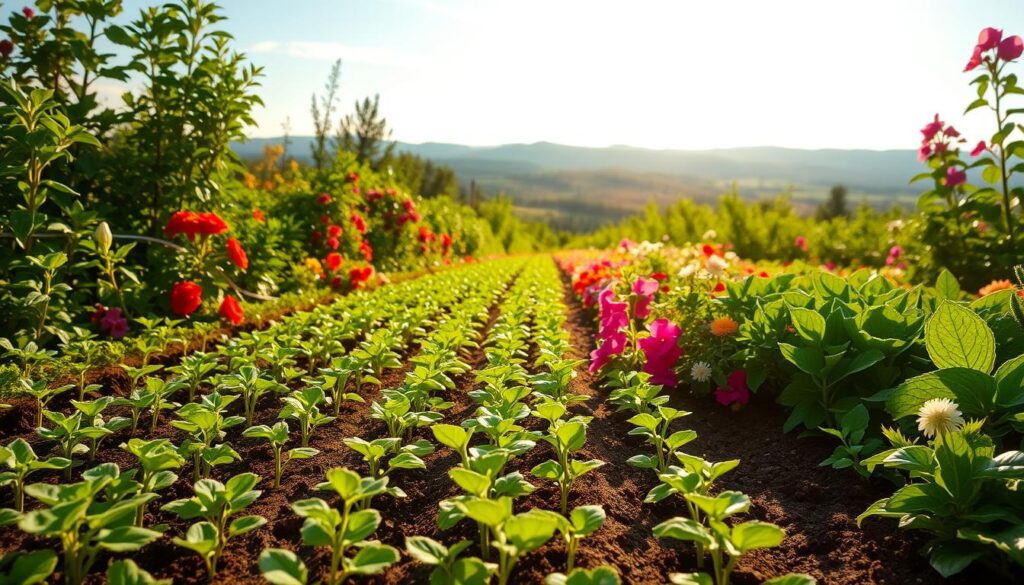
The guide also highlights the difference between indoor and direct sowing crops. Tomatoes, peppers, and eggplant take 6-8 weeks to grow before transplanting. Cucumbers and zucchini are ready in just 3 weeks.
By knowing these differences, gardeners can plan their planting schedule. This ensures a rich harvest. The optimal planting times and guide are crucial for garden success.
Summer and Fall Crop Planting Strategies
As summer comes, gardeners have a chance to plant more. It’s key to know the planting schedules and planting timeline for different crops. This way, you can get a good harvest in the fall.
Cool-season crops like broccoli and kale do well in the summer. They’re ready for fall. Beans and cucumbers can also be planted in summer for a late harvest.
It’s important to know how long each crop takes to grow. This helps plan your planting. For example, succession planting lets you keep getting lettuce and radishes.
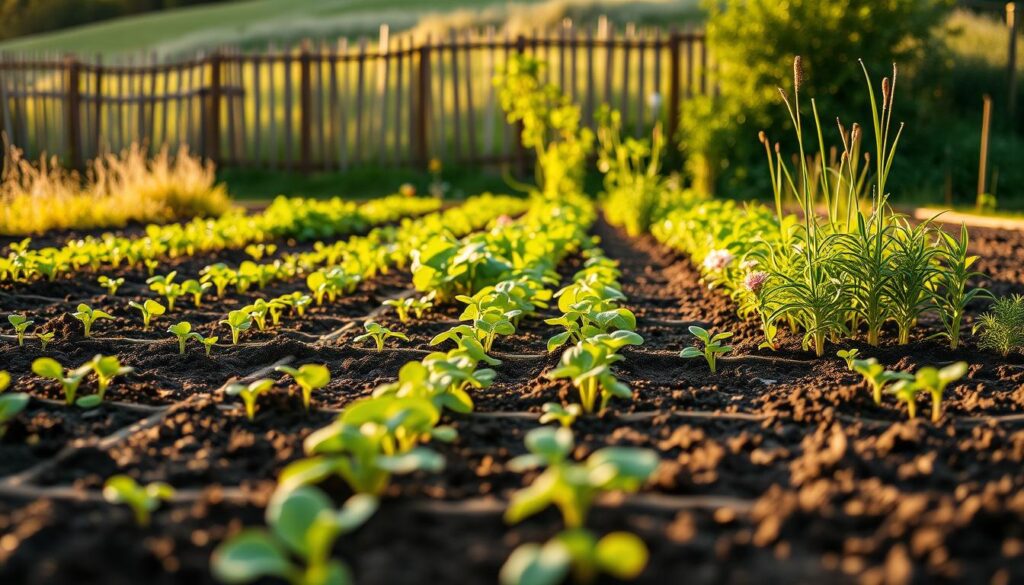
To get the most out of summer and fall, try succession planting and cover cropping. These methods improve soil and increase yields. With a good planting schedule and planting timeline, you’ll have plenty to harvest all season.
Soil Temperature and Moisture Requirements
Knowing about soil temperature and moisture is key for the best seasonal planting dates and a custom crop planting calendar. Soil temperature impacts how seeds germinate. If it’s not right, seeds might not grow well or at all. Different crops need different temperatures to start growing.
For example, amaranth needs soil between 68-75°F, leek between 60-85°F, and artichoke between 70-80°F. A soil thermometer helps track this temperature. It’s suggested to check the soil temperature twice a day. Place the thermometer 1″–2″ in the soil for seeds and as deep as the pot for transplants.
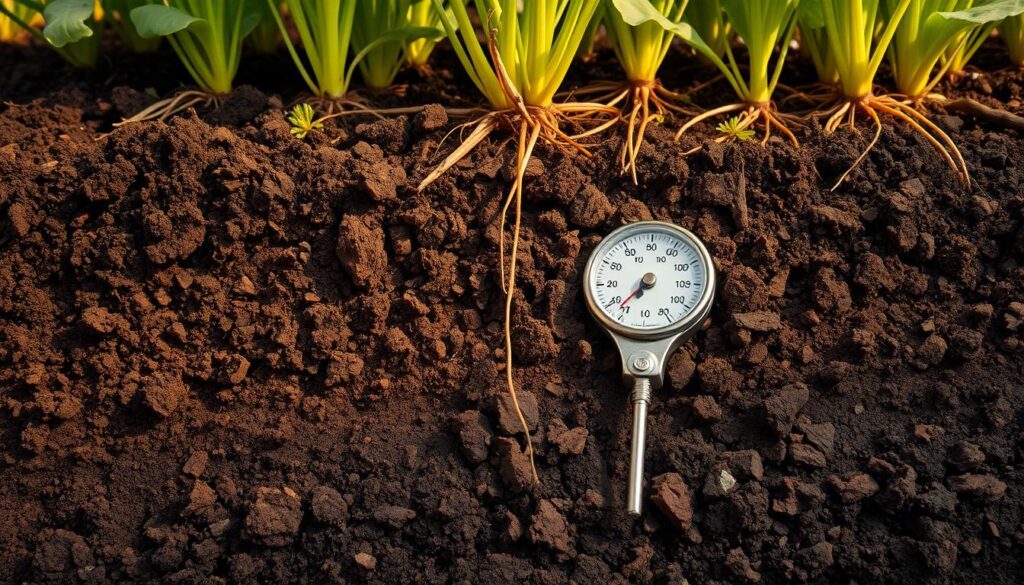
Soil temperature often lags behind air temperature in spring. This affects when you can start planting. Using a soil thermometer and knowing the best soil temperature for each crop helps gardeners plan better. This way, they can make sure their crops grow well.
| Crop | Ideal Soil Temperature Range |
|---|---|
| Amaranth | 68-75°F |
| Leek | 60-85°F |
| Artichoke | 70-80°F |
Tools and Resources for Planning Planting Dates
Planning when to plant can be tricky. But with the right tools, gardeners can make a agricultural planting calendar that fits their area. A good planting season guide helps gardeners choose the best times to plant. This ensures their crops grow well.
Gardeners can start by using digital apps. These apps give info on weather, soil temperature, and moisture. They help figure out the best planting times for different crops and places. Weather systems also offer live updates, helping gardeners adjust their plans.
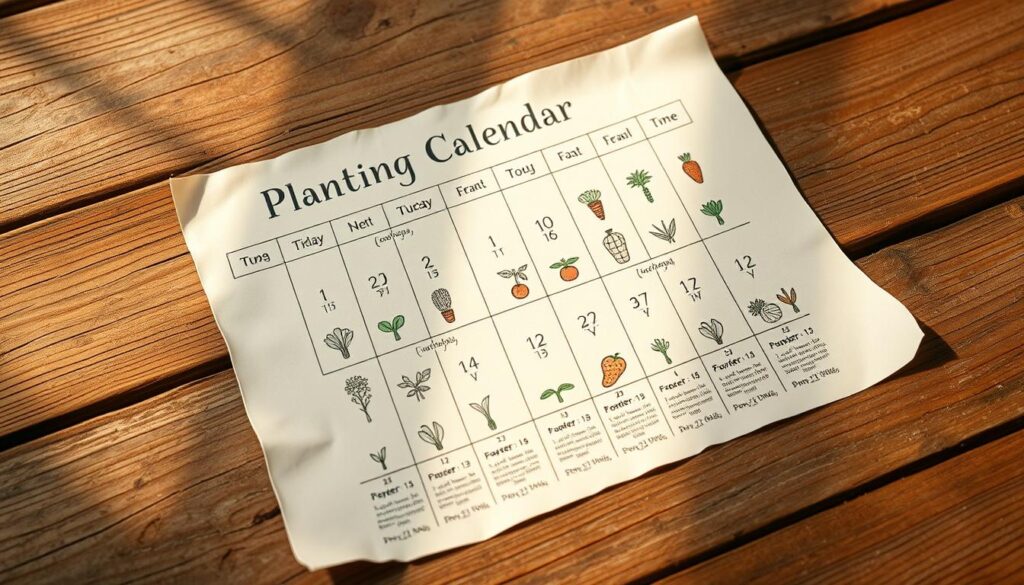
- Agricultural extension services, which offer info on local weather, soil, and pests
- Online gardening communities, where gardeners share tips on planting and caring for crops
- Local nurseries and gardening stores, which know the best plants for the local climate and soil
By using these tools and resources, gardeners can make a detailed planting season guide. This guide helps them manage planting and crop care. With a well-planned agricultural planting calendar, gardeners can look forward to a successful harvest.
Common Planting Date Mistakes to Avoid
Timing is key when planting crops. Knowing the best planting times and schedules is vital for a good harvest. Yet, many gardeners make mistakes that harm their crops.
One big error is not knowing the days-to-maturity for each crop. This can cause crops to grow poorly or not at all. For instance, in northern areas, planting too late can mean crops won’t be ready before the first frost.
Another mistake is ignoring each crop’s unique needs. Different crops need different amounts of sunlight, water, and soil. Not meeting these needs can stunt growth and lead to disease.
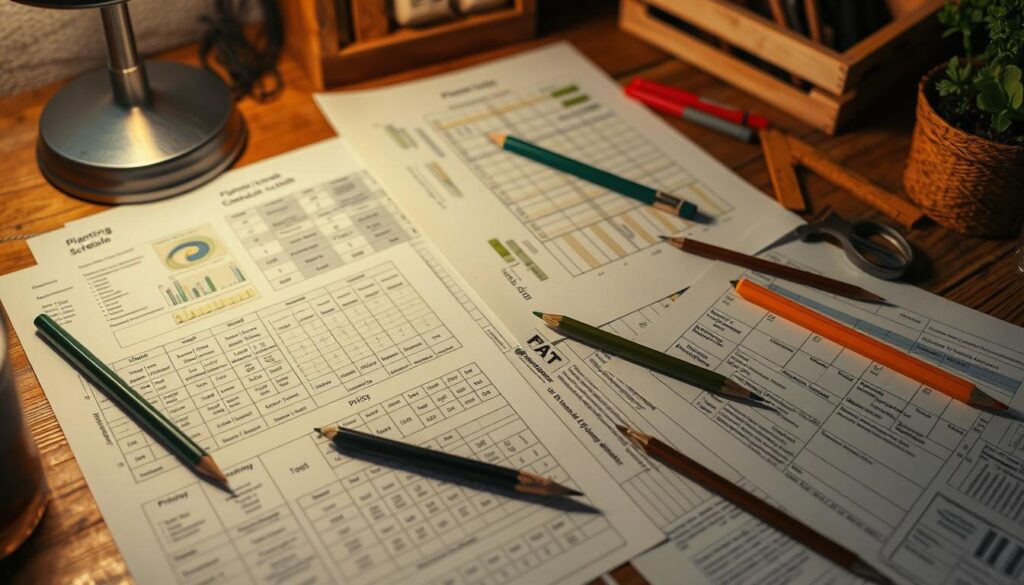
To avoid these mistakes, gardeners should plan their planting schedule carefully. This includes knowing the best planting times and each crop’s needs. Regular garden care, like weeding and checking for pests, also helps prevent problems.
Some important things to consider when planning your planting schedule are:
- Understanding the days-to-maturity for each crop
- Considering the specific requirements for each crop, such as sunlight, water, and soil needs
- Proper spacing to increase yields and prevent overcrowding
- Regular garden maintenance to prevent infestations and reduce disease problems
By avoiding common mistakes and planning well, gardeners can have a successful harvest. Remember, the right planting times and schedules are key to a good harvest.
Adapting Planting Dates for Climate Change
As the world’s climate keeps changing, it’s crucial to adjust crop planting calendar and planting timeline. This ensures crops grow well. Climate change can make growing seasons shift and weather patterns change. These changes can hurt crop yields a lot.
For instance, a study showed that wheat and rice might grow more with more CO2 in the air. But, maize, sorghum, and millet could grow less because of warmer temperatures.
Farmers can try different ways to adapt to these changes. They can:
- Change when they plant to fit new growing seasons
- Grow crops that can handle warmer weather and changing weather
- Save water in the soil to lessen drought and flood effects
By knowing how climate change affects crop planting calendar and planting timeline, farmers can make smart choices. They can adapt their farming to fight climate change’s bad effects. Tools like CROPWAT 8.0 software can help plan crop calendars and figure out water needs.
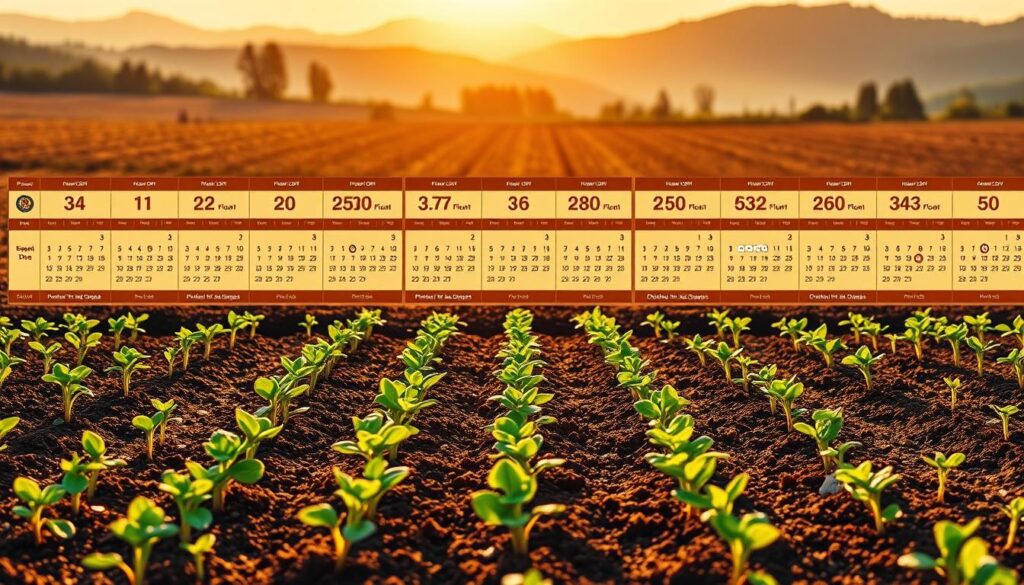
Conclusion: Maximizing Success Through Proper Timing
As we wrap up this guide, it’s clear how vital planting times and an agricultural planting calendar are. Knowing what affects crop growth helps gardeners make better choices. This leads to greater success in their gardens.
Studies show that when you plant soybeans early, like in Minnesota, it can really help. It makes use of resources better and increases productivity. But, if planting is delayed, yield losses grow fast. It’s also key to adjust to weather changes and tweak seeding rates to keep harvests steady.
Staying up-to-date and using the right tools are essential for planting crops. By following the advice in this guide, gardeners can achieve success year after year.
FAQ
What is the importance of crop planting dates?
Planting crops at the right time is key to getting good yields and avoiding crop failure. Knowing when to plant each crop can save money and help the environment.
What are the key factors that influence planting times?
Climate, soil temperature, and moisture levels are important for planting. These factors help gardeners make a planting calendar that fits their local conditions.
How do regional climate zones affect planting decisions?
Climate zones, like USDA Hardiness Zones, greatly affect planting times. Gardeners must know their zone to plan the best planting times for their crops.
What information is included in the spring planting guide?
The spring guide tells you when and how to plant common crops. It also covers soil prep, fertilizing, and pest control in spring.
How can gardeners plan for summer and fall crop planting?
Gardeners can use succession planting and know each crop’s days-to-maturity. This helps plan for mid-season and fall harvests.
What are the soil temperature and moisture requirements for different crops?
Knowing the soil and moisture needs for each crop is crucial. It helps gardeners create a planting calendar for the best results.
What tools and resources are available for planning planting dates?
Gardeners can use digital tools, weather systems, and extension services. These help create a planting calendar that fits their local conditions.
What are some common planting date mistakes to avoid?
Avoid not knowing the best planting times for each crop. Also, don’t ignore the specific needs for a successful harvest.
How can gardeners adapt their planting dates for climate change?
Adapting to climate change means adjusting planting times and using resilient crops. This ensures the best outcomes despite weather changes.
Source Links
- PLANTING CALENDAR – Know when it’s the best time to plant! – https://www.seedsnow.com/blogs/news/best-time-to-plant-wheel?srsltid=AfmBOor9JPpAMcAfBbL5os2J2mDuAN9n2m2nBQyJk-zZwV_Sb3YgJgnN
- Beginner’s Guide to Crop Planning: Map, Estimate, and Set Target Dates — Sierra Flower Farm – https://www.sierraflowerfarm.com/blog/2022/1/15/crop-planning-for-the-flower-farmer
- Understanding When to Plant Vegetables – https://www.almanac.com/understanding-when-plant-vegetables
- The Planting Date Conundrum for Corn (Purdue University) – https://www.agry.purdue.edu/ext/corn/news/timeless/pltdatecornyld.html
- Corn & Soybean Planting Updates: Delays and Potential Yield Impacts and Recommendations – https://agcrops.osu.edu/newsletter/corn-newsletter/2024-14/corn-soybean-planting-updates-delays-and-potential-yield-impacts
- Six Tips for Determining Planting Dates | CROPLAN Seed – https://www.croplan.com/agronomy/six-tips-for-determining-planting-dates
- Field Notes: Corn and soybean planting – Are we on schedule? – https://blog-crop-news.extension.umn.edu/2024/05/field-notes-corn-and-soybean-planting.html
- Planting Methods, Rates, and Dates – https://covercrops.ces.ncsu.edu/planting-methods-rates-and-dates/
- How will climate change affect crop yields in the future? – https://ourworldindata.org/will-climate-change-affect-crop-yields-future
- Hardiness Zones and Ecoregions for Climate-Smart Gardening – The National Wildlife Federation Blog – https://blog.nwf.org/2024/02/hardiness-zones-and-ecoregions-for-climate-smart-gardening/
- Climate change is shifting plant growth zones. Here’s what to know for your garden this year – https://www.pbs.org/newshour/science/climate-change-is-shifting-plant-growth-zones-heres-what-to-know-for-your-garden-this-year
- When to Start Seeds: Your Guide to Spring Planting – https://www.tenthacrefarm.com/when-to-start-seeds-30-garden-vegetables/
- How to Grow Early Spring Vegetables – https://longwoodgardens.org/blog/2021-02-25/how-grow-early-spring-vegetables
- Extension | Succession Planting – https://extension.wvu.edu/lawn-gardening-pests/gardening/garden-management/succession-planting
- Recommended Dates for Fall Cover Crop Planting – https://extension.psu.edu/recommended-dates-for-fall-cover-crop-planting
- Summer and Fall Vegetable Planting Guide for the Treasure Valley Zones 6b-7a – https://snakeriverseeds.com/blogs/news/summer-and-fall-vegetable-planting-guide
- Soil Temperature for Higher Germination – https://www.botanicalinterests.com/community/blog/soil-temperature-for-higher-germination/?srsltid=AfmBOoqVP80otXWcCr0qI1op-EH9-4szRMIo9n1H045DyxVhMq8-EqPu
- Agronomy eUpdate April 18th, 2024 : Issue 1000 – https://eupdate.agronomy.ksu.edu/article/soil-temperature-weather-forecast-and-seed-quality-are-critical-for-cotton-establishment-588-3
- The Importance of Soil Temperature: A Guide to Optimal Crop Growth | Just Grow Something with Karin Velez – https://justgrowsomethingpodcast.com/blog/the-importance-of-soil-temperature-a-guide-to-optimal-crop-growth
- Vegetable Gardening for Beginners: The Complete Guide – https://www.almanac.com/vegetable-gardening-for-beginners
- California Vegetable Planting Calendar: A Quick and Easy Guide – https://ponicslife.com/california-vegetable-planting-calendar-a-quick-and-easy-guide/
- 12 Beginner Gardening Mistakes to Avoid This Summer – https://www.epicgardening.com/beginner-gardening-mistakes/
- Common Mistakes Beginner Gardeners Make + How to Fix Them – Boots & Hooves Homestead – https://bootsandhooveshomestead.com/common-mistakes-beginner-gardeners-make-how-to-fix-them/
- Climate change will affect food production, but here are the things we can do to adapt – https://ourworldindata.org/climate-change-will-affect-food-production-things-can-adapt
- Crop calendar optimization for climate change adaptation in yam farming in South-Kivu, eastern D.R. Congo – https://journals.plos.org/plosone/article?id=10.1371/journal.pone.0309775
- Optimizing soybean management: The Impact of planting dates on Minnesota farms – https://blog-crop-news.extension.umn.edu/2024/03/optimizing-soybean-management-impact-of.html
- Notes on soybeans as planting gets underway – farmdoc – https://farmdoc.illinois.edu/field-crop-production/notes-on-soybeans-as-planting-gets-underway.html

